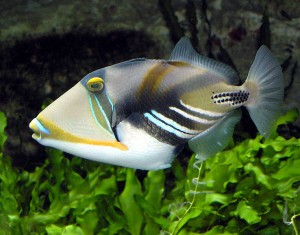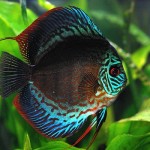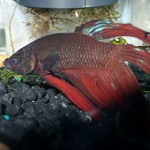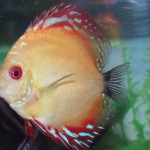Getting to know your fish and their natural behaviors well is always a good idea, since it will make it much easier for you to detect problems at an early stage. Treating health problems before they get a chance to bloom is much easier than trying to save severely affected fish. In this article, we will discuss a few common symptoms that aquarists should look out for in the aquarium.
In some cases, a “symptom” can be a perfectly normal part of your fish’s behavior and observing your fish while they are still happy and healthy is the only way of distinguishing alarming symptoms from normal changes. Reading books and articles about your species is also a good idea since it will give you a heads up on what to expect in the future. How does your particular species act when it is getting ready to spawn? How does it alter its colors to show submission? What can refusal to eat mean in many African cichlids?
Abnormal swimming
Abnormal swimming is usually one of the first symptoms of something being wrong in your aquarium. The fish can for instance seem “drunk”, swim in circles or simply drift with the current. It can sink to the bottom and be unable to raise itself, or float at the surface, incapable of swimming any further down. Severe health problems can even make a fish swim upside down with its belly pointing towards the surface.
Respiration and gills
Gasping and labored breathing is an important warning sign that should not be taken lightly. It can be caused by a health problem or by improper aquarium maintenance. Generally speaking, it should prompt you to increase aeration and carry out a series of frequent water changes. Hopefully, the problem will go away. If not, the fish is probably diseased.
Different fishes have different respiratory rates and it is therefore impossible to say how fast a “normal” fish breathes. Observe your fishes carefully while they are still healthy and remember how they normally breathe. It should be noted that many fish species are capable of breathing oxygen directly from the air and it is perfectly normal for such species to swim up to the surface once in a while, gasping for air.
Gill sheets that loose their normal color and turns pale is another serious warning sign that should never be neglected. Most healthy fishes have bright pink gill sheets, but there are a few exceptions; the gill sheets of the popular Betta splendens are for instance pigmented.
Anorexia
Anorexia can come in many different forms and knowing the normal feeding habits of you fish are therefore imperative. Some fish refrain from eating completely when sick, while others eat much less than normal, or only certain types of food. It is also quite common for sick fish to take a piece of food into its mouth and then promptly spit it out. Anorexia can be brought on by a myriad of reasons; one of the most common ones being constipation. Constipation is especially common in fish with laterally compressed bodies where there is little room for the intestines. As the constipation proceeds, it will normally cause a significant swelling of the abdomen and can prove fatal.
Anorexia does not have to be brought on by disease; it can just as well be a sign of improper living conditions or an unsuitable diet. In some cases, simply increasing the water temperature will make the problem go away. In other cases, fish anorexia is completely normal and will go away of it self. Mouthbrooding species can for instance refrain from eating while brooding and female fishes can stop eating as they get ready to spawn since the large collection of ripe eggs inside them blocks their intestines.
Body shape and contours
Watching the body shape and contours will give you a lot of information about your fish. It is a good habit to set aside a few minutes every day to check your fish for changes in body shape, swellings, torn or clamped fins, and so on. Swelling of the abdomen can be a good thing when it is observed in egg-bearing or pregnant females, but it can also be a sign of constipation, internal parasites or bacterial infections.
Coloration
A fish that does not feel good will often dampen its colors. Loss of coloration can be brought on by virtually anything, from skin problems and internal disease to low levels of oxygen. Frightened or otherwise stressed fish will also normally look less vibrant than normally. Keep the aquarium well decorated, provide your fish with a wealth of hiding spots and keep your eyes out for bullies and fin nippers. Dampening the light can also prove beneficial.
A submissive male can voluntarily choose to dampen his color and clamp his fins to avoid picking fights with a dominant male in the aquarium. In this scenario, the loss of coloration is actually a good thing since it will prevent violence and injury. Loss of coloration can also be associated with spawning; the fish can for instance be exhausted after raising a batch of fry or putting up with a lot of aggression during the pre-spawning period.
Cysts, sores, blood-stains etcetera
Diseases of the skin will often manifest in the form of cysts, spots, sores, slime, ragged white to brown patches, or small blood stained patches (so called echymoses). Examples of commonly occurring skin problems in aquariums are Ich, Velvet and fungus attacks. A fish with skin problems will often be itchy and scratch itself against rough surfaces in the aquarium.

















Leave a Reply